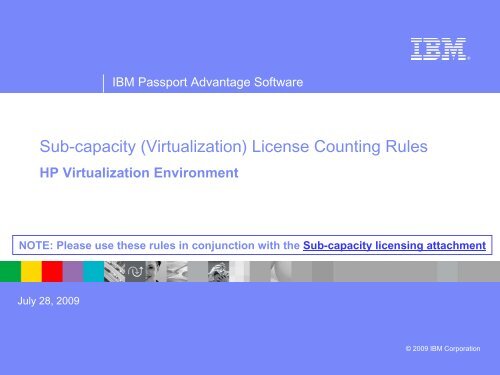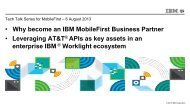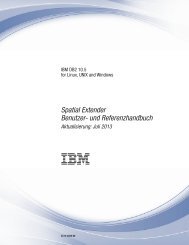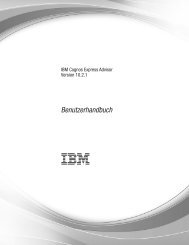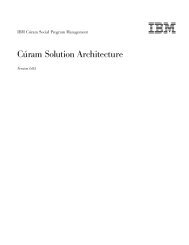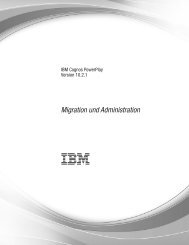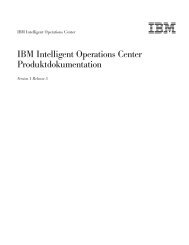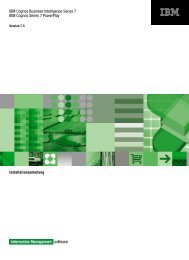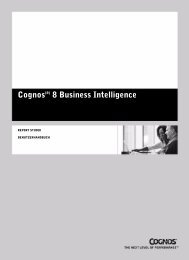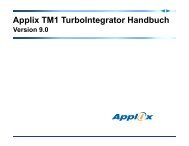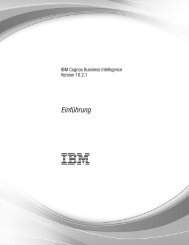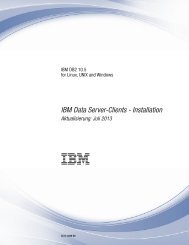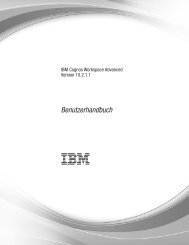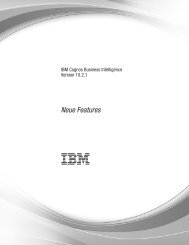HP Integrity
HP Integrity
HP Integrity
Create successful ePaper yourself
Turn your PDF publications into a flip-book with our unique Google optimized e-Paper software.
IBM Passport Advantage Software<br />
Sub-capacity (Virtualization) License Counting Rules<br />
<strong>HP</strong> Virtualization Environment<br />
NOTE: Please use these rules in conjunction with the Sub-capacity licensing attachment<br />
July 28, 2009<br />
®<br />
© 2009 IBM Corporation
IBM Passport Advantage Software – Virtualization Capacity Licensing for <strong>HP</strong> Virtualization<br />
Index of Items<br />
Summary of Virtualization Capacity Licensing Requirements (page 3)<br />
ILMT License Counting – Definitions, Scenarios & Rules (page 4-10)<br />
– Definitions (page 4-5)<br />
– Scenarios<br />
• <strong>HP</strong>-UX nPars (page 6)<br />
• <strong>HP</strong>-UX vPars (page 7)<br />
• <strong>HP</strong>-UX dynamic vPars (page 8)<br />
• <strong>HP</strong>-UX <strong>Integrity</strong> Virtual Machine (page 9)<br />
• <strong>HP</strong> Virtualization Technology (page 10)<br />
– Rules (page 11)<br />
Manual Calculation of Virtualization Capacity – if allowed (page 12-15)<br />
– Eligibility Criteria & Requirements (page 13)<br />
– Rules (page 14)<br />
– Worksheet Example (page 15)<br />
Other<br />
– Key Web Links (page 16<br />
2<br />
July 28, 2009<br />
© 2009 IBM Corporation
IBM Passport Advantage Software – Virtualization Capacity Licensing for <strong>HP</strong> Virtualization<br />
Sub-capacity Licensing Requirements Summary<br />
Customers must:<br />
Agree to the terms of the Sub-capacity Attachment, and follow Virtualization<br />
Capacity License Counting rules for their Eligible Virtualization Environment(s)<br />
Use Eligible Sub-capacity Products<br />
Use Eligible Virtualization Technologies<br />
Use Eligible Processor Technologies<br />
Use the IBM License Metric Tool (ILMT) and maintain report documentation<br />
Tivoli Asset Discovery for Distributed V7.2 (TADd) may be used in lieu of IBM<br />
License Metric Tool V7.2<br />
3<br />
Certain ILMT / TADd use exceptions may apply<br />
PLEASE NOTE:<br />
The above is only a summary. For details about sub-capacity licensing requirements, see the Sub-capacity Attachment<br />
and other information referred to above, at Passport Advantage Sub-capacity licensing information<br />
Customers are responsible for the installation of the IBM License Metric Tool and for the server it runs on.<br />
July 28, 2009<br />
© 2009 IBM Corporation
IBM Passport Advantage Software – Virtualization Capacity Licensing for <strong>HP</strong> Virtualization<br />
Definitions & Parameters<br />
Cell:<br />
– A cell or cell board is a module that primarily houses processors, memory, and the cell controller<br />
application-specific integrated circuits (ASICs). Up to four processor (chips) are contained in a cell.<br />
Hard Partition (nPar)<br />
– Offer electrical and software isolation. Each nPar contains one or more cells (containing processors and<br />
memory) that are assigned to the partition for its exclusive use.<br />
– Absolute minimum is one cell. The cell does not have to be fully populated (e.g. can have just one<br />
processor (chip).<br />
– Any changes to the number of cores requires a reconfiguration and reboot of the hard partition<br />
Virtual Partition (vPar)<br />
– are separate operating system instances on the same nPartition or system with operating system,<br />
application, and resource isolation.<br />
– <strong>HP</strong>-UX 11i Virtual Partition enable you to dynamically move processing power between vPars as your<br />
workload requirements change.<br />
– You can allocate cores to a vPar down to a granularity of a single core<br />
• Absolute minimum number of cores = 1. Per vPar minimum number of cores is configurable. Changes to the per-<br />
vPar minimum requires a reboot of the vPar.<br />
• Absolute maximum number of cores for a vPar = ( Total number of cores on the system minus number of cores<br />
associated with other vPars on the system). Per vPar maximum number of cores is configurable. Changes to the<br />
per-vPar maximum requires a reboot of the .<br />
4<br />
July 28, 2009<br />
© 2009 IBM Corporation
IBM Passport Advantage Software – Virtualization Capacity Licensing for <strong>HP</strong> Virtualization<br />
Definitions & Parameters<br />
<strong>HP</strong> <strong>Integrity</strong> Virtual Machines<br />
– Is a software partitioning product that provides virtualization of resources, shared<br />
CPU, shared I/O, and resourcing based on demand and entitlement for <strong>HP</strong><br />
<strong>Integrity</strong> servers running <strong>HP</strong>-UX<br />
– <strong>HP</strong> <strong>Integrity</strong> VM provides the ability to allocate CPU and I/O to an application at<br />
a granularity less than that of the physical hardware yet keeps applications<br />
separate from one another in their own operating system instance.<br />
– <strong>Integrity</strong> VM virtualizes the processing cores and software for the guest<br />
operating systems running on “virtual CPUs” in the virtual machine. A virtual<br />
CPU represents no more than one processor core.<br />
– You can allocate cores to a <strong>Integrity</strong> VM down to a granularity of a single core<br />
5<br />
• Absolute minimum of vCPUs (cores) = 1 core<br />
• Current absolute maximum of vCPUs (cores) = 4 cores<br />
• The entitlement (share of physical core per vCPU) may be changed dynamically in<br />
a range from 5% to 100%. This does not impact licensing. A single physical core<br />
can support up to 20 virtual machines<br />
July 28, 2009<br />
© 2009 IBM Corporation
IBM Passport Advantage Software – Virtualization Capacity Licensing for <strong>HP</strong> Virtualization<br />
License Counting: <strong>HP</strong>-UX nPars<br />
License entitlements required are based on processor core capacity available to the<br />
software in the nPartitions (nPars)<br />
Each nPAR has a minimum of 1 Cell. A cell or cell board is a module or housing that<br />
may contain up to four processors (chips).<br />
– Note: Each nPar in this example has a Cell with 4 single-core processors, for a total of 4 cores per nPar and<br />
12cores for server<br />
For the example below:<br />
– WebSphere Application Server (WAS): PVUs for 8 cores need to be licensed<br />
– DB2 Enterprise Server Edition (DB2): PVUs for 8 cores need to be licensed<br />
nPars<br />
6<br />
1<br />
<strong>HP</strong>-UX 11i<br />
2<br />
WAS<br />
3<br />
July 28, 2009<br />
4<br />
1<br />
<strong>HP</strong>-UX 11i<br />
2<br />
WAS<br />
DB2 ESE<br />
3<br />
4<br />
1<br />
<strong>HP</strong>-UX 11i<br />
DB2 ESE<br />
2<br />
Processor cores<br />
3<br />
4<br />
© 2009 IBM Corporation
IBM Passport Advantage Software – Virtualization Capacity Licensing for <strong>HP</strong> Virtualization<br />
License counting: <strong>HP</strong>-UX static vPars<br />
License entitlements required are based on processor core capacity available to the<br />
software in the Virtual Partitions (vPars)<br />
For the example below:<br />
– WAS: PVUs for 10 cores need to be licensed<br />
– DB2: PVUs for 4 cores need to be licensed<br />
7<br />
July 28, 2009<br />
<strong>HP</strong>-UX 11i<br />
WAS<br />
<strong>HP</strong>-UX 11i<br />
WAS<br />
DB2<br />
<strong>HP</strong>-UX 11i<br />
DB2<br />
1 2 3 4 5 6 7 8 1 2 1 2<br />
Processor cores<br />
vPars<br />
© 2009 IBM Corporation
IBM Passport Advantage Software – Virtualization Capacity Licensing for <strong>HP</strong> Virtualization<br />
License counting with dynamic vPars (I)<br />
<strong>HP</strong>-UX OS provides the capability to dynamically move processor core resources between vPars<br />
(Virtual Partitions).<br />
Customer must acquire PVUs for the highest* number of processor core capacity available to the IBM<br />
software<br />
Example:<br />
Customer’s basic<br />
configuration:<br />
WAS 10<br />
DB2 4<br />
Changed for<br />
batch peak:<br />
WAS 10<br />
DB2 4<br />
Changed for<br />
simulation:<br />
WAS 10<br />
DB2 6<br />
8<br />
July 28, 2009<br />
<strong>HP</strong>-UX 11i<br />
WAS<br />
<strong>HP</strong>-UX 11i<br />
WAS<br />
DB2<br />
<strong>HP</strong>-UX 11i<br />
1 2 3 4 5 6 7 8 1 2 1 2<br />
<strong>HP</strong>-UX 11i<br />
WAS<br />
<strong>HP</strong>-UX 11i<br />
WAS<br />
DB2<br />
DB2<br />
<strong>HP</strong>-UX 11i<br />
1 2 3 4 5 6 7 8 9 1 1 2<br />
<strong>HP</strong>-UX 11i<br />
WAS<br />
<strong>HP</strong>-UX 11i<br />
WAS<br />
DB2<br />
DB2<br />
<strong>HP</strong>-UX 11i<br />
1 2 3 4 5 6 1 2 3 4 1 1<br />
License PVUs for 10 WAS cores (consistent throughout) + 6 DB2 EE cores (from Configuration B)<br />
* Maximum number of cores per-vPar<br />
DB2<br />
© 2009 IBM Corporation
IBM Passport Advantage Software – Virtualization Capacity Licensing for <strong>HP</strong> Virtualization<br />
License Counting – <strong>Integrity</strong> Virtual Machine (on <strong>HP</strong>-UX 11i v2 host)<br />
Server with 4 processor cores<br />
9<br />
VM # 1<br />
WAS<br />
1<br />
July 28, 2009<br />
VM # 2<br />
WAS<br />
2 3 4<br />
VM # 3<br />
WAS<br />
DB2<br />
WAS DB2 Virtual<br />
CPUs<br />
Note: Each Virtual CPU is equal to 1 processor core<br />
Cores to be licensed<br />
<strong>Integrity</strong> VM<br />
2 2 VM # 1<br />
2 2 VM # 2<br />
2 2 2 VM # 3<br />
6 2 Total<br />
4 4 Capacity limit<br />
4 2 Total cores to<br />
license<br />
License rule: the lower of the sum of<br />
each VM for a product or the processor<br />
core capacity of the server<br />
6 Virtual CPUs<br />
4 Physical Cores in the<br />
Server<br />
© 2009 IBM Corporation
IBM Passport Advantage Software – Virtualization Capacity Licensing for <strong>HP</strong> Virtualization<br />
<strong>HP</strong> Virtualization Technology - <strong>HP</strong> Virtual Server Environment<br />
Single<br />
Physical Node<br />
Single OS image<br />
server<br />
10<br />
July 28, 2009<br />
T I M E<br />
nPartitions<br />
Hard partitions within<br />
a node<br />
Single node<br />
nPar 1<br />
• OS image with HW fault<br />
isolation<br />
• Dedicated CPU, RAM & I/O<br />
nPar 2<br />
nPar n<br />
Virtual Partitions or<br />
<strong>HP</strong> <strong>Integrity</strong> Virtual<br />
Machines<br />
within a hard partition<br />
nPar 1<br />
vPar 1<br />
OS image with SW fault isolation<br />
• Dedicated CPU, RAM<br />
vPar n<br />
nPar 2<br />
IVM 1<br />
OS image with SW fault isolation<br />
• Virtualized and Shared CPU, I/O<br />
• Virtualized memory<br />
© 2009 IBM Corporation
IBM Passport Advantage Software – Virtualization Capacity Licensing for <strong>HP</strong> Virtualization<br />
ILMT Licensing Counting Rules – for Single Server Environments<br />
License Rules for nPAR, vPAR & Intergity VM for each product:<br />
for a nPAR, maximum processor core capacity available to the nPAR<br />
for a vPAR, the highest* amount of processor core capacity available to the vPAR<br />
lower of the sum of the vPAR or the processor core capacity of the nPAR they reside in<br />
for <strong>Integrity</strong> Virtual machine the maximum number of Virtual CPU in a VM. Each<br />
Virtual CPU is equal to 1 processor core.<br />
11<br />
lower of the sum of the VMs or the processor core capacity of the nPAR they reside in<br />
Lower of the sum of the processor cores for the above or the capacity of the server<br />
* The greater of what the vPAR starts with or the result of a dynamic change in<br />
processor core capacity (Maximum per-vPar number of cores)<br />
July 28, 2009<br />
© 2009 IBM Corporation
IBM Passport Advantage Software – Virtualization Capacity Licensing for <strong>HP</strong> Virtualization<br />
The licensing rules in the preceding pages reflect how ILMT will<br />
operate to calculate PVUs<br />
If ILMT does not yet support a Eligible Virtualization Environment, or<br />
you qualify for an exception to use ILMT, you will need to follow the<br />
Manual Calculation of Virtualization Capacity.<br />
The Manual Calculation of Virtualization Capacity rules can be<br />
found in the following pages<br />
To find out if a Eligible Virtualization Technology is supported by<br />
ILMT visit<br />
Passport Advantage Sub-capacity licensing information<br />
12<br />
July 28, 2009<br />
© 2009 IBM Corporation
IBM Passport Advantage IBM Passport Software Advantage – Virtualization Software Capacity – Sub-capacity Licensing Licensing for <strong>HP</strong> Virtualization<br />
Manual Calculation of Virtualization Capacity<br />
Eligibility Criteria: Customers must use the IBM License Metric Tool, with the<br />
following exceptions<br />
ILMT does not support the Eligible Virtualization Environment<br />
Customer has fewer than 1000 employees and contractors - Tool recommended<br />
Customer server Full Capacity licensing for a PVU product is less than 1000 PVUs<br />
(on servers with an Eligible Virtualization Environment) - Tool recommended<br />
Requirements: For the above exceptions, customers must manually manage,<br />
track and prepare Audit Reports<br />
An Audit Report must be prepared at least once per quarter and identify the<br />
following detail: Each Eligible Sub-Capacity Product deployed in each Eligible<br />
Virtualization Environment<br />
An Eligible Virtualization Environment can be a Single Server or a Group of Servers<br />
(Server Cluster)<br />
In addition to the above detail, the report should provide a summary total of the<br />
required number of PVUs by and for each Eligible Sub-Capacity Product<br />
Audit Reports must be prepared as frequently as is required to maintain a history of<br />
increases to Virtualization Capacity and Full Capacity<br />
Each Audit Report must be signed and date stamped, at least once per quarter<br />
The above is only a summary. For detailed terms please see the Sub-capacity licensing attachment<br />
13 July 28, 2009<br />
© 2009 IBM Corporation
IBM Passport Advantage IBM Passport Software Advantage – Virtualization Software Capacity – Sub-capacity Licensing Licensing for <strong>HP</strong> Virtualization<br />
Manual Calculation of Virtualization Capacity – Rules<br />
14 July 28, 2009<br />
For Single Server Environments:<br />
License Rules for nPAR, vPAR & Intergity VM for each product:<br />
for a nPAR, maximum processor core capacity available to the nPAR<br />
for a vPAR, the highest* amount of processor core capacity available to the vPAR<br />
for <strong>Integrity</strong> Virtual machine the maximum number of Virtual CPU in a VM. Each Virtual CPU is equal to 1<br />
processor core.<br />
*The greater of what the partition starts with or the result of a dynamic change in processor core capacity<br />
(Maximum per-vPar number of cores in whole cores)<br />
The PVU licensing requirement is based on the maximum number of virtual processor cores in<br />
the nPARs, vPARs and VMs available to a product (lower of the sum of the virtual cores or<br />
the server capacity)<br />
If you want to use sub-capacity licensing for any other <strong>HP</strong> technology, including lower<br />
of the sum of VMs or the nPAR they reside in, you must use the ILMT tool<br />
© 2009 IBM Corporation
IBM Passport Advantage IBM Passport Software Advantage – Virtualization Software Capacity – Sub-capacity Licensing Licensing for <strong>HP</strong> Virtualization<br />
Manual Calculation of Virtualization Capacity - Worksheet Example<br />
Worksheet has 3 tabs;<br />
use the following tabs<br />
Instructions & Information<br />
Single Server<br />
Web Link: Worksheet for<br />
Manual Calculation of<br />
Virtualization Capacity<br />
15 July 28, 2009<br />
© 2009 IBM Corporation
IBM Passport Advantage Software – Virtualization Capacity Licensing for <strong>HP</strong> Virtualization<br />
Key Web Links<br />
PVU<br />
PVU table and other information<br />
Sub-capacity<br />
Passport Advantage Sub-capacity licensing Information<br />
Virtualization Capacity License Counting Rules<br />
Sub-capacity licensing attachment<br />
16<br />
July 28, 2009<br />
© 2009 IBM Corporation


